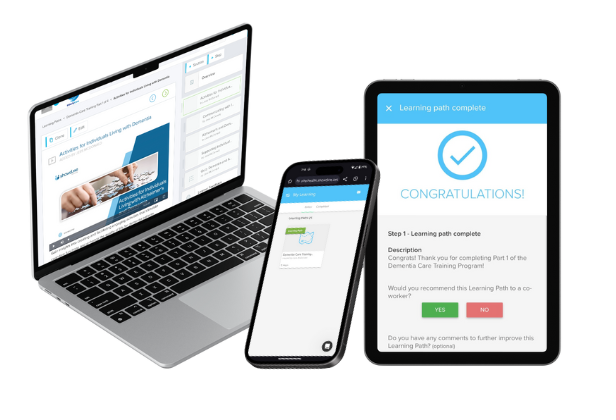7 Practical Tips For Engaging Reluctant Learners
Post - 7 Practical Tips For Engaging Reluctant Learners
Post-acute care providers recognize that keeping staff trained and up-to-date isn’t just a requirement—it’s a cornerstone of quality care. Yet, despite the clear importance of ongoing training, it’s often something that post-acute care employees tend to avoid or put off until the last minute. Whether it’s due to time constraints, a lack of interest, or simply feeling overwhelmed, motivating your team to engage in training can be a significant challenge. However, with the right approach, even the most reluctant learners can be transformed into eager participants. Here’s how:
1. Make Training Relevant
When training feels irrelevant, it becomes harder to engage. One way to counteract this is by ensuring the content is specifically tailored to the challenges they face on the job and their day-to-day responsibilities.
Post-acute care settings are highly specialized, and the needs of staff can vary drastically. Customizing training content to specific roles helps overcome the common objection that “this doesn’t apply to me,” ensuring that employees see the immediate value in what they’re learning.
At Showdme, we intentionally keep our course catalog lean to ensure that every course is relevant, up-to-date, and addresses the needs of post-acute care employees. Our courses are designed to be accessible and engaging, ensuring that learners at all levels—from frontline workers to seasoned clinicians—can easily understand and apply the material.
Recommended Reading: 7 Must-Ask Questions For Selecting A Learning Management System (LMS) In Post-Acute Care READ MORE
2. Embrace Microlearning
Busy post-acute care workers often struggle to find time for training. Microlearning offers a solution by making training bite-sized and accessible, allowing staff to engage with the content without disrupting their workflow.
Instead of asking staff to sit through an hour-long course on infection control, break it into five-minute segments that cover key points like hand hygiene, personal protective equipment (PPE), and environmental cleaning. Each segment can be completed during short breaks or downtime, allowing staff to fit training into their busy schedules without feeling overwhelmed.
3. Leverage Incentives
Training may be a requirement, but given the reluctancy of employees to prioritize it, you may want to consider putting a rewards and recognition system behind it. Doing so gives staff another reason to prioritize turning it into a positive and motivating experience rather than an obligation.
Something as simple as recognizing the first ten employees who completing training, or even offering a small gift card or training bonus to those who finish within a certain time frame can go a long way in driving completion rates up, faster.
4. Make Learning Flexible
The rigid training schedules that often come with in-person training can be a significant barrier to participation. Offering an online, mobile-friendly option like Showdme removes this obstacle and allows healthcare workers to complete training at their own pace.
It also allows them to complete training whenever and wherever they find the time, whether that’s while they’re waiting in the car line to pick up their child from school, in the morning while they drink their coffee, or on the bus home.
5. Highlight Training As A Career Growth Opportunity
Many post-acute care employees view training as something they “have to do,” but when you frame it as an opportunity for growth and advancement, it becomes something they “want to do.”
One of the best ways to motivate staff to engage in training is by showing how it contributes to their career growth. If they understand how training leads to promotions, pay raises, or new responsibilities, they’ll be more likely to prioritize it.
This, paired with trainings that go beyond the requirements to advance their knowledge and skills, can help shift the perspective on training, significantly boosting engagement and participation.
6. Foster A Culture Of Learning
When staff feel that learning is part of the organization’s culture—not just something tacked on—they are more likely to engage. And that’s why a culture of continuous learning starts at the top.
Leadership at all levels should show they are invested in the ongoing development of their employees. This could include investing in technology that helps better facilitate training and makes it easier for their team to complete. It also includes how the organization speaks to training. Is it just a burdensome requirement? Or an essential component in the organization’s ability to exceed care standards.
7. Regularly Communicate The Impact Of Training
Often, staff are reluctant to engage in training because they don’t see the immediate value. By regularly communicating how training improves patient care, compliance, or job satisfaction, you can help staff understand why it matters.
Share data and real-world examples that show the impact of training. For instance, if fall prevention training led to an 80% reduction in client or resident falls, share that statistic with the team. Seeing the direct impact of their learning makes staff more invested in continuing their education. And regularly tying training to outcomes that matter most to your employees—like better patient care or improved job performance—can help keep them motivated and engaged.
Motivating reluctant learners is no easy task, but by understanding their challenges and offering practical, flexible solutions, you can foster a culture where training is embraced.
At Showdme, we understand the unique challenges post-acute care providers face with it comes to training. Our fully-managed compliance training service delivers a relevant, mobile-friendly experience that makes it easy for your employees to fit learning into their busy schedules. Our team proactively reminds staff of upcoming deadlines and is standing by to offer support to ensure nothing gets in the way of completing training.
Want to learn more about our unique, concierge-style approach to compliance training? Click here for more information.

Let Us Show You More
See how showdme's unique service-first approach to training helps hundreds of healthcare organizations ensure compliance. Request a demo today!

